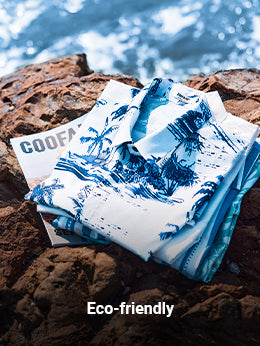How to Take Care of Your Knitted Sweater?

Navigation
- Wash Gently with a Light Touch
- Dry Flat to Maintain Shape
- Store Properly to Avoid Moths and Pilling
- Turn Inside Out and Handle Gently
- Use Tools to Remove Pills
- Follow These Tips for Sweater Success
- Frequently Asked Questions
Knit sweaters hold a special place in many of our hearts. They keep us cozy through crisp autumn days and cold winter nights. We love how they add softness, texture, and color to our wardrobes. But unlike t-shirts or jeans, knits require a little extra TLC. Without the proper care, these treasured garments can lose their shape, pill excessively, shrink, and fade.
If you've invested in quality knitwear, either handmade or store-bought, you'll want it to last. That wonderful cashmere sweater passed down from grandma? The bright Fair Isle yoke pullover you splurged on? With some simple tricks, you can keep them looking great for many seasons to come. Let's review the key steps so you can give your knits the attention they deserve.
Wash Gently with a Light Touch
First rule of washing knits: skip the vigorous scrubbing! Aggressive washing can distort the stitches and cause the yarn fibers to felt or pill. Always opt for a gentle cycle and cold water setting. Warm water may be okay for pure wool, but hot water is a no-go.
Protect your sweater in a mesh laundry bag before tossing in the washing machine. This prevents excess agitation. Use a mild liquid detergent, no bleach, and skip the fabric softener-it can leave residue on the yarn fibers. When in doubt, opt for handwashing in the sink using a soap specifically formulated for wool and delicate knits.

Dry Flat to Maintain Shape
Once your knits are squeaky clean, it's crucial to dry them flat. The weight of water can stretch the stitches out of shape, so always lay knits down on a towel or mesh drying rack. I like to lightly block pieces while drying to help them hold their form.
If your washing machine has a handwash or delicate cycle with a low spin option, that can reduce excess water before drying. Under no circumstances should you toss a knit sweater in the dryer-the heat will cause it to shrink. Air drying is best.

Store Properly to Avoid Moths and Pilling
You just spent time getting your sweater in great shape, so store it carefully between wears. Fold loosely rather than hanging to prevent stretching on the hanger. Use cedar blocks or lavender sachets in your sweater storage bins-the natural aromas deter moths looking for a tasty wool meal.
Place the sweater in a breathable cotton storage bag. This protects from dust and debris that can cause pilling while still allowing fresh air circulation. Don't pack sweaters too densely or pile too much on top that could misshape them.

Turn Inside Out and Handle Gently
When wearing your sweater, there are still opportunities for pilling and damage. Flip it inside out anytime you wash. This prevents the agitation of the washing machine from causing excess pilling on the exterior.
Put your sweater on gently, lifting it over your head rather than pulling it on hastily. Tugging and stretching the fabric repeatedly can cause it to lose its shape. When not wearing it, store it folded or on a hanger-don't leave it crumpled in a ball!
Use Tools to Remove Pills
Despite your best efforts, pilling still happens. When you notice those annoying little balls of fiber on the surface, don't reach for the scissors! This can damage the sweater. Instead, use a sweater stone, electric de-piller, or abrasive razor very gently across the surface to remove pills without harming the stitches. Take your time and be careful not to apply too much pressure.

Follow These Tips for Sweater Success
Caring for your knits does require some special attention, but a few simple habits will keep them looking fabulous:
- Handwash when possible using cool water and mild wool detergent
- Dry flat and block sweaters to maintain shape
- Store in breathable cotton bags with cedar or lavender
- Fold loosely and handle gently to avoid stretching
- Use a de-piller tool to remove pills and fuzz
With proper techniques for washing, drying, and storing, your favorite knitwear will last for many more cozy seasons. Show your sweaters you care by handling them with love and care. Trust me, you'll be so glad you took the time to care for these wonderful fabrics and keep them looking their best.

Frequently Asked Questions
- How often should I wash my knitted sweater?
You don't need to wash your knitted sweater after every wear. In general you can wash your knitted sweater after about 10-15 wears or every 3-6 months. For light wear and non-stained sweaters, every 10-15 wears is usually sufficient. This allows the natural oils from your skin to condition the fibers without buildup.If the sweater starts to look or smell visibly dirty from wear, stains, or perspiration, it's time for a wash even if it hasn't been 10-15 wears yet. Very active sweaters worn for sports may need washing more frequently like after 5 wears or monthly.
- How can I prevent my knitted sweaters from shrinking or losing their shape?
- Turn the sweater inside out to protect the exterior fibers.
- Use a gentle wash cycle in cold water to avoid heat-induced felting.
- Add garments one at a time and don't overcrowd the machine.
- Use a small amount of a gentle liquid detergent made for handwash only.
- For itchy wool sweaters, add a tablespoon of white vinegar to help relax the fibers.
- Rinse thoroughly and air dry flat rather than tumble drying which can cause pulling.
- Can I use fabric softener when washing my knitted sweaters?
No, it's generally not recommended to use fabric softener when washing knitted sweaters. Why? Here are the reasons:
- Fabric softener can coat wool and other animal fibers, preventing them from breathing properly. This can cause the yarn to degrade more quickly over time.
- The coating from softener can also affect how dyes adhere to the yarn, possibly causing colors to fade more easily with repeated washing.
- Softener residues leave a tacky feeling that can attract dirt and pills on fabric surfaces. This is especially undesirable for wool sweaters that are meant to breathe.It can reduce a sweater's natural ability to wick away moisture, making it less warm or comfortable when wet.
Read More
- 8 Benefits of Wearing Cotton Linen Clothing– coofandy
- Men's Shirt Style Guide: Breaking Down Different Shirt Styles and How – coofandy
- DIY Suit Cleaning Tips– coofandy
- Beat the Heat with Cotton Linen Pants: The Ultimate Summer Men's Wardrobe Staple– coofandy
- Why Casual Loose Fit Sports Sets are a Must-Have for Men– coofandy





























